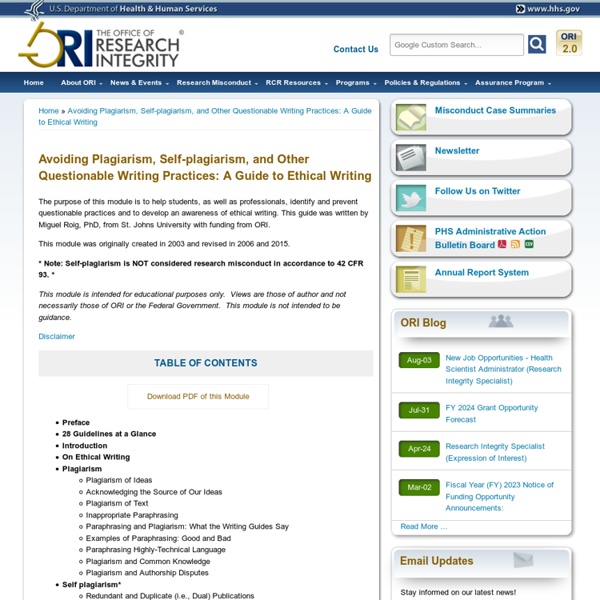Citing Yourself
If you cite or quote your previous work, treat yourself as the author and your own previous course work as an unpublished paper, as shown in the APA publication manual. For example, if Marie Briggs wanted to cite a paper she wrote at Walden in 2012, her in-text citation might look like this: Briggs (2012) asserted that previous literature on the psychology of tightrope walkers was faulty in that it "presumed that risk-taking behaviors align neatly with certain personality traits or disorders" (p. 4). And in the reference list: Briggs, M. (2012). manuscript, Walden University. If your original work contained citations from other sources, you will need to include those same citations in the new work as well, per APA. According to Briggs (2012), recent psychologists such as "Presley and Johnson (2009) too quickly attributed risk-taking to genetic factors, ignoring the social family issues that often influence the decision to explore pursuits such as tightrope walking" (p. 5).
Frequently Asked Questions
What is group registration of unpublished works? What does “GRAM” stand for? How do I register musical works (with or without lyrics) with the same application? How do I register sound recordings with the same application? Can I register a work that was previously published as a single before it was published on the album? How do I register photographs, artwork, or liner notes with the same application? What’s the difference between a “musical work” and a “sound recording”? Can I register a musical work (with or without lyrics) and sound recordings with the same group registration application? Can I register musical works (with or without lyrics), photographs, artwork, and liner notes with the same application? Where can I learn about this group registration option? When did this change go into effect? When was this change announced? Do I need to submit my claim through the electronic registration system? Where do I find information about the online registration system? What is a collective work?
APA Formatting and Style Guide
Note: This page reflects the latest version of the APA Publication Manual (i.e., APA 7), which released in October 2019. The equivalent resource for the older APA 6 style can be found here. Reference citations in text are covered on pages 261-268 of the Publication Manual. What follows are some general guidelines for referring to the works of others in your essay. Note: On pages 117-118, the Publication Manual suggests that authors of research papers should use the past tense or present perfect tense for signal phrases that occur in the literature review and procedure descriptions (for example, Jones (1998) found or Jones (1998) has found...). When using APA format, follow the author-date method of in-text citation. If you are referring to an idea from another work but NOT directly quoting the material, or making reference to an entire book, article or other work, you only have to make reference to the author and year of publication and not the page number in your in-text reference.
Son of Citation Machine
How to Cite Something You Found on a Website in APA Style
by Chelsea Lee Perhaps the most common question we get about APA Style is “How do I cite a website?” or “How do I cite something I found on a website?” First, to cite a website in general, but not a specific document on that website, see this FAQ. Once you’re at the level of citing a particular page or document, the key to writing the reference list entry is to determine what kind of content the page has. The Publication Manual reference examples in Chapter 7 are sorted by the type of content (e.g., journal article, e-book, newspaper story, blog post), not by the location of that content in a library or on the Internet. What seems to flummox our readers is what to do when the content doesn’t fall into an easily defined area. Content in that egg white area may seem confusing to cite, but the template for references from this area is actually very simple, with only four pieces (author, date, title, and source): Examples of Online References
Columbia says historian's acclaimed book on North Korea was plagiarized; publisher says it's been taken out of print
Charles Armstrong, Korea Foundation Professor of Korean Studies in the Social Sciences at Columbia University, plagiarized parts of his award-winning book on North Korea, Tyranny of the Weak: North Korea and the World, 1950-1992. He’s currently on sabbatical and will retire at the end of 2020, the university told Armstrong’s colleagues this week. “These findings were made in accordance with our policy, which required a confidential preliminary review by an inquiry committee, an investigation by a separate ad hoc faculty committee, oversight and recommendations by the university’s standing Committee on the Conduct of Research, and final decisions by the executive vice president for research and the provost,” Maya Tolstoy, dean of the Faculty of Arts and Sciences, wrote in an email to professors that was obtained by Inside Higher Ed. Armstrong declined to comment. But the findings certainly aren’t a surprise to him or many others who study North Korea. Michael V.



